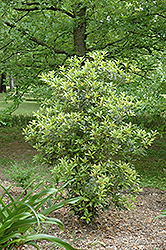It's all about ...
plants

UNC Sweet Olive
Osmanthus x fortunei 'UNC'
Height: 20 feet
Spread: 20 feet
Sunlight:
![]()
![]()
Hardiness Zone: 7b
Other Names: Tea Olive, False Holly, Olive Holly
Description:
A rare and beautiful variety with spiny, lustrous leaves that are holly-like, but it's actually related to lilac and privet; a rounded shrub or small tree, covered with fragrant, cream trumpet flowers in fall; more adaptable than holly
Ornamental Features
UNC Sweet Olive is covered in stunning fragrant creamy white tubular flowers along the branches in early fall. Its attractive small spiny oval leaves remain dark green in colour throughout the year.
Landscape Attributes
UNC Sweet Olive is a dense multi-stemmed evergreen perennial with an upright spreading habit of growth. Its medium texture blends into the garden, but can always be balanced by a couple of finer or coarser plants for an effective composition.
This is a relatively low maintenance plant, and is best cut back to the ground in late winter before active growth resumes. Deer don't particularly care for this plant and will usually leave it alone in favor of tastier treats. Gardeners should be aware of the following characteristic(s) that may warrant special consideration;
- Spiny
UNC Sweet Olive is recommended for the following landscape applications;
- Accent
- Mass Planting
- Hedges/Screening
- General Garden Use
- Topiary
Planting & Growing
UNC Sweet Olive will grow to be about 20 feet tall at maturity, with a spread of 20 feet. It has a low canopy with a typical clearance of 1 foot from the ground. Although it is technically a woody plant, this slow-growing plant can be expected to behave as a perennial in our climate if planted outdoors over the winter, usually regrowing from its base (crown) the following year. As such, gardeners should take into consideration that it will perform differently than it would in its native habitat.
This plant does best in full sun to partial shade. It does best in average to evenly moist conditions, but will not tolerate standing water. It is not particular as to soil pH, but grows best in rich soils. It is highly tolerant of urban pollution and will even thrive in inner city environments. This particular variety is an interspecific hybrid.
This plant is not reliably hardy in our region, and certain restrictions may apply; contact the store for more information.
